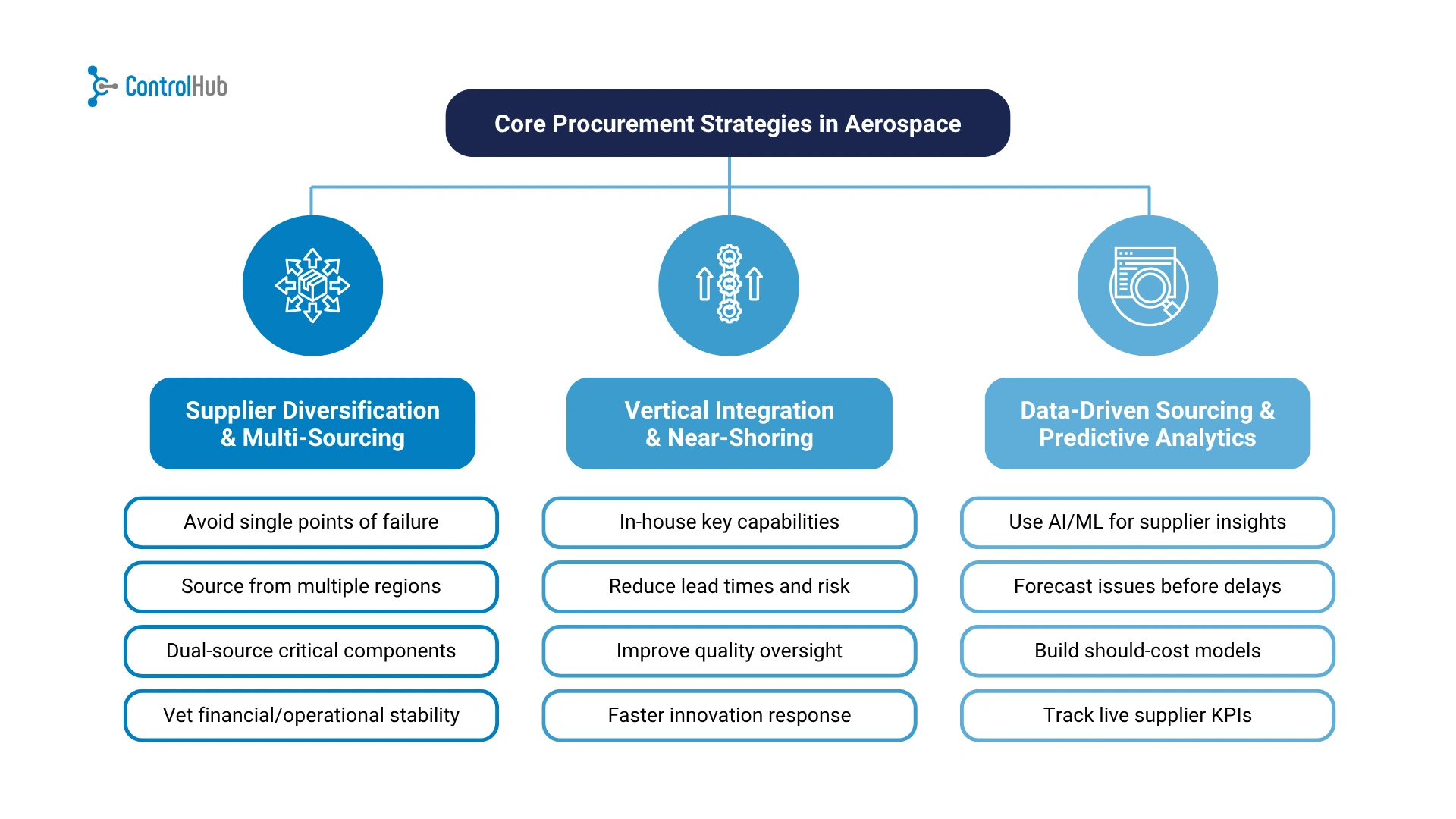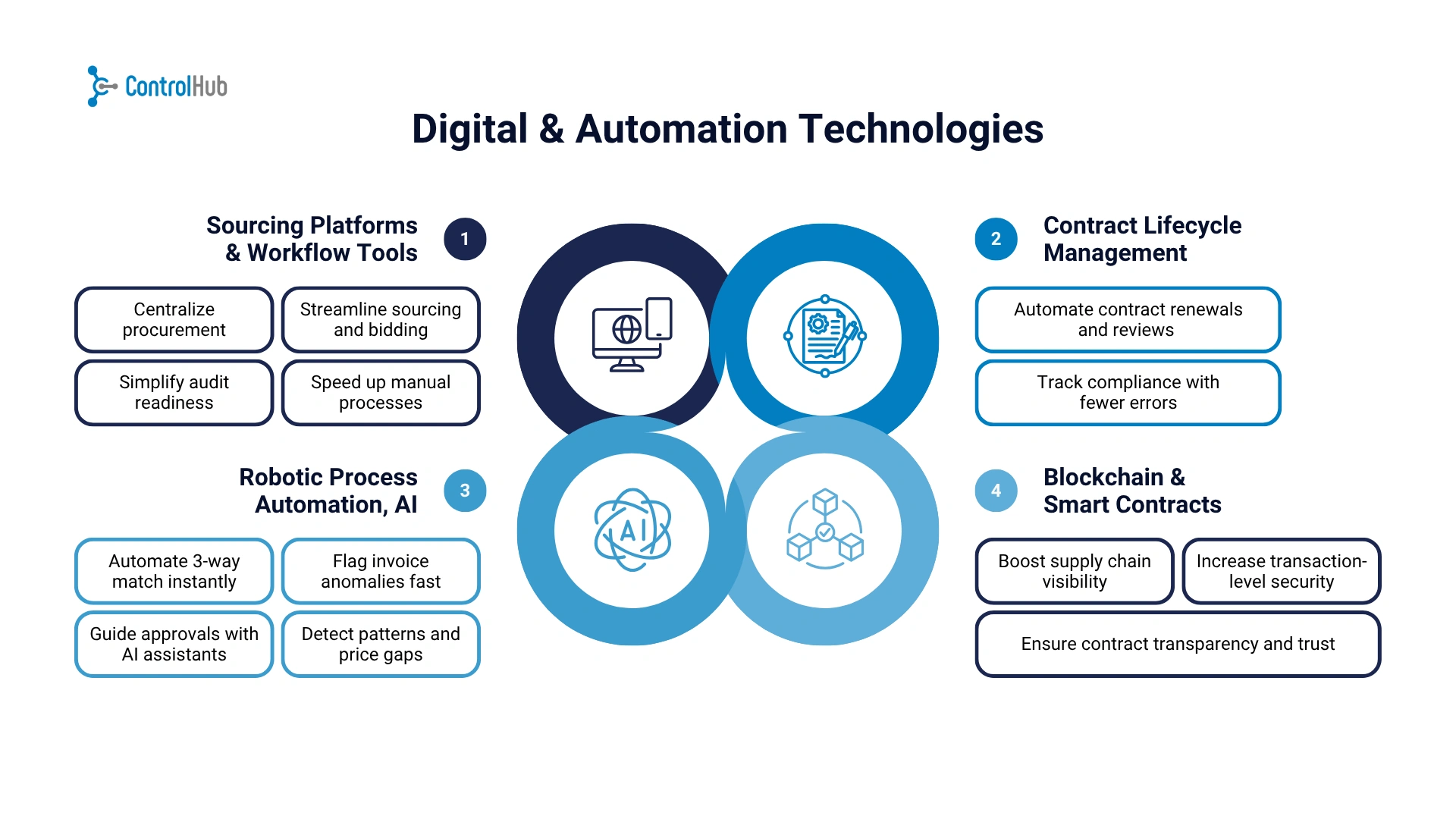Free Supplier Risk Scorecard Download
Download our free supplier risk scorecard here!
Download the free tool!AI Summarize:
People always say procurement is hard stuff.
There are relationships to build, quality levels to double-check, costs to save, and…
Well, you get the idea
But what happens when what you need to source isn't offered everywhere?
What if the regulations you must meet are absolutely strict?
Those questions are only part of what happens when, aside from dealing with the usual procurement headaches, you need to deal with the challenges of the aerospace industry.
Tricky?
Yes, but definitely not impossible.
What's Procurement for the Aerospace Industry?
At first glance, it might seem like your regular procurement process. You identify a need, search for a supplier, sign a deal, and that's it.
And while in theory that's how procurement works, if your company operates in the aerospace industry, you know there's a sense of additional complexity.
You need to be super careful in terms of performance, compliance, and, of course, seeking the most long-term reliable partner to work with.
And your suppliers? It might not necessarily be located remotely close to your location.
Here’s what makes procurement in this space so specific (and, let’s say, intense):
- Absolutely regulated: Yes, nowadays you can find regulations almost everywhere, but in the aerospace industry, things are a bit more special. Every single material, component, and supplier has to follow very specific quality requirements. A single mistake can put a halt to your whole operation.
- Long lead times: This is a problem that all businesses face at some point, regardless of their industry. But for businesses working in the aerospace sphere, it has a different meaning, because it's kind of common to find that the items and parts your products need aren't widely available. So you are forced to wait as long as it's required.
- Supply chains are fragile: For real, working in the aerospace industry means you only have a bunch of suppliers, not because you want it, but because there aren't many options in the market. So, let's say something goes wrong with a couple of suppliers. Total disaster.
- Low margin for mistakes: One faulty part on a commercial jet could cost millions (and lives). So quality, redundancy, and proactive supplier management aren't nice-to-haves; they're survival tools.
Core Procurement Strategies in Aerospace
Supplier Diversification & Multi-Sourcing
Yes, yes
We just reaffirmed that finding lots of suppliers isn't as straightforward as in other industries, but that isn't a justification to depend solely on a single vendor.
Especially if that single provider is hundreds of miles away on a different continent.
If possible, you want to:
- Avoid single points of failure by building supplier networks in different locations.
- Dual-source your most important components; it might increase your budget, but it can protect your business from unexpected problems.
- Always check for financial and operational health.
Vertical Integration & Near-shoring
You start noticing a pattern here, right?
One of the most challenging things about having a business in the aerospace industry is keeping the right number of suppliers at all times.
More aerospace companies are pulling key capabilities in-house or moving suppliers closer to home.
- Near-shoring, for example it's pretty useful to cut response time and potential risks.
- Vertical integration gives you more oversight of quality, lead times, and innovation.
Data-driven sourcing and predictive analytics
Relying on data is a must-have for any procurement strategy. For the aerospace industry, it's even more important to work with the right data so you can forecast potential problems before they affect your operations.
- Use AI/ML tools to monitor and understand how reliable your suppliers are and predict delays.
- Build should-cost models so you can negotiate more confidently and expose overcharge.s
- Track real-time supplier KPIs for transparency across tiers
Free Supplier Risk Scorecard Download
Download our free supplier risk scorecard here!
Download the free tool!Digital & Automation Technologies
Still dealing with endless spreadsheets that make less sense with every process?
Yeah, that can get messy really fast.
And when you are working in such a special industry, messy means risky.
Fortunately, the tools are out there, and they’re getting smarter by the minute.
Sourcing platforms and workflow tools.
Centralize your procurement processes in a single place with the right systems so you can move faster than you would do manually.
E-sourcing platforms have been around for a while with high rates of success.
The reason?
It seriously facilitates the whole sourcing process. From managing bids to keeping records ready for any audits.
Another point to consider lies close to the approach you follow to review your main supplier contracts and implement contract lifecycle management strategies on time.
Robotic process automation, AI
Here's a sad fact…
Depending on how you look at it, you don’t need a human to match invoices or check part codes. Let AI take care of the repetitive stuff.
You can…
- Automate 3-way match and flag anomalies instantly
- Deploy AI chatbots or workflow assistants to guide engineers and buyers through complex approval chains.
- Use machine learning models to detect purchasing patterns, price anomalies, or compliance gaps.
Blockchain and smart contracts
Blockchain is becoming more and more popular for small, medium, and large businesses alike. The technology is great for visibility and security.
Two key values for a super-regulated industry like aerospace.
Free Supplier Risk Scorecard Download
Download our free supplier risk scorecard here!
Download the free tool!Supplier Relationship Management and Contracting
If you have had the chance to read some of our other articles, you'll know how important it is to go beyond business transactions with your suppliers and actually build long-term relationships that can hold your hand when things seem to go wrong.
For aerospace companies, the relevance of that is fundamental for the success and stability of their daily operations.
Build real partnerships
You can’t afford arm-length relationships in this space.
- Bring suppliers in early during design or engineering phases, especially for custom parts; this is tremendously helpful to determine how viable your procurement strategy is in real life.
- Once you've a solid list of suppliers, don't hesitate to co-developing solutions or design tweaks when specs hit manufacturing constraints.
- Share forecasts, engineering changes, and risks openly, and expect the same in return. That's how relationships are formed.
Performance-based contracts
Markets change overnight, and things don't always have to be static.
Yes, even contracts
You can set up key terms in your contracts with suppliers like time expected, delivery aspects, quality, and overall responsiveness.
In case something isn't as expected, it's easier to move away.
Consider as well building in escalation clauses, raw material price adjustments, and supply continuity plans
Keep communication open
Well, this sounds easy
And in theory it's pretty simple, but with a busy business running, it might pass overlooked.
Communicate with your suppliers when things are difficult, but don't forget to sit down and have a regular chat with them as part of your normal routine. Treat critical suppliers like part of your team, loop them in on upcoming changes or volume shifts.
Risk Management & Resilience Measures
Aerospace procurement leaders are realizing that just-in-time doesn’t cut it anymore. As McKinsey puts it:
“Invest for growth by increasing redundancy in critical raw materials and parts segments.”
Map your supply chain.
You can’t manage what you can’t see. And that's a big problem for your supply chain.
Here's how you can prevent annoying disruptions:
- Go beyond tier-1, map tier-2 and even tier-3 suppliers for critical parts
- Identify single points of failure, including subcontracted processes or small-volume components
- Assess your suppliers for geopolitical exposure, financial instability, and production bottlenecks.
Check financial health
Ever had to deal with unpleasant surprises regarding your suppliers?
Yeah…
That's not good at all.
But it's definitely something you can stop from happening by implementing the right measures.
- Use tools or third-party services to track financial risk scores, workforce issues, and regulatory red flags.
Buffer inventory
- Hold buffer inventory on long-lead or high-risk items, not everything
- Explore vendor-managed inventory (VMI) for critical hardware or chemicals
- Align buffers with your risk profile, not old habits
Sustainable & ESG-Oriented Procurement
Between regulatory pressure, investor expectations, and customer demand, procurement teams are now expected to build ESG thinking right into their sourcing strategies. And it’s not about looking great in a nice PR piece, prioritizing ethical, resilient supply chains can actually protect you from long-term risk nowadays.
One key move is to prioritize suppliers with clear sustainability credentials and traceability.
That means looking beyond ISO certificates and diving into how materials are sourced, whether emissions are tracked, and if labor practices meet global standards. Aerospace has a unique opportunity here: many of its suppliers already maintain detailed quality documentation.
ESG just needs to be layered into that same discipline
Free Supplier Risk Scorecard Download
Download our free supplier risk scorecard here!
Download the free tool!Free Supplier Risk Scorecard Download
Download our free supplier risk scorecard here!
Download the free tool!Key Takeaways
- Long lead times and regulatory complexity aren’t going away,procurement teams need smarter tools, tighter supplier relationships, and better forecasting to stay ahead.
- Digital isn’t optional anymore. From RPA to sourcing platforms and smart contracts, modern tech helps cut through the manual chaos and reduce costly errors.
- Suppliers aren't just vendors—they're risk partners. Building trust, sharing early forecasts, and co-developing solutions pays off when disruption hits.
- You can't manage risk if you don’t map it. Dig into tier-2 and tier-3 exposure, monitor supplier health, and design buffers that actually make sense.
- ESG is no longer “nice to have.” Integrate sustainability and diversity into sourcing criteria to align with where aerospace—and the world—is going.
- People still matter. Great procurement isn’t just about tech or contracts—it’s about cross-functional teams, upskilled buyers, and collaborative culture.
- Small moves can lead to big savings. Things like aggregating spend categories or syncing sourcing with production plans can unlock double-digit efficiencies.
%20(1).avif)

















.png)


